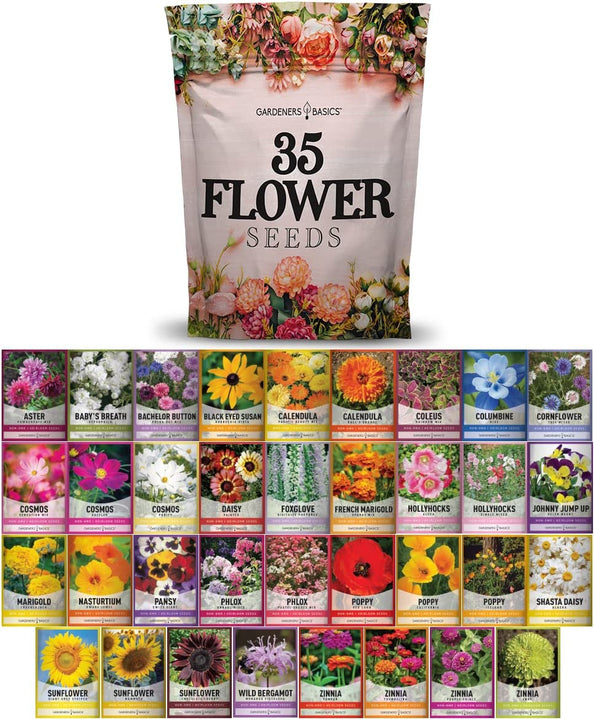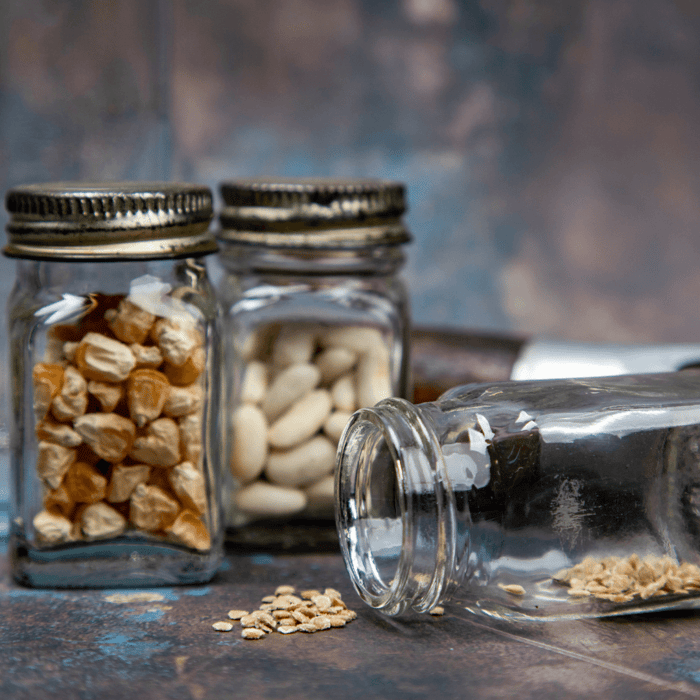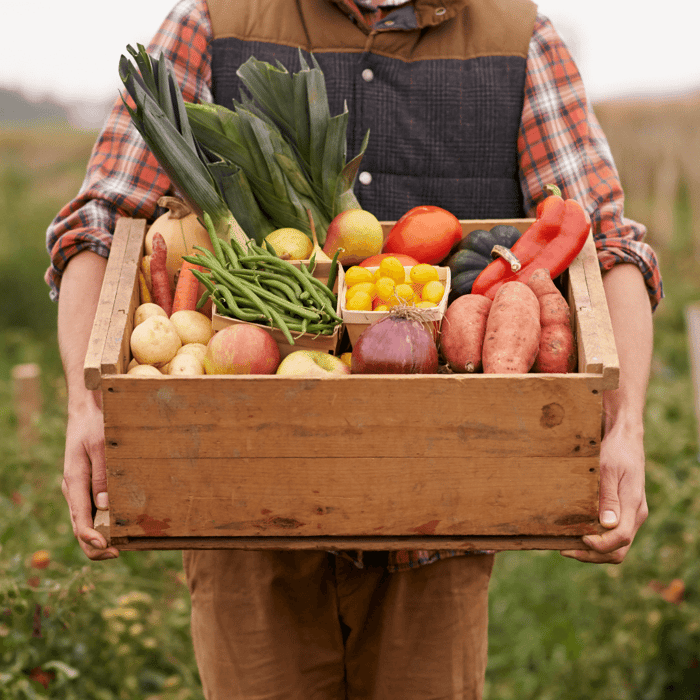Hello, fellow gardeners! As an avid gardener, I have a special heart for heirloom seeds. The history and uniqueness they bring to my garden and the variety of colors, flavors, and textures make them a real treasure. In this extensive article, I will provide a detailed, step-by-step guide on how long do heirloom seeds last and how to store them properly to ensure maximum viability. So, let's explore the captivating world of heirloom gardening together! Heirloom seeds are also great for survival since you can harvest them and replant them for future gardens.
Table of Contents
- Understanding Heirloom Seeds
- Factors Influencing Seed Viability
- Heirloom Seed Storage: Best Practices
- How to Conduct a Germination Test
- Preserving Heirloom Seeds: Long-Term Storage Tips
- Reviving Older Seeds: Techniques for Success
- Conclusion: The Value of Heirloom Seeds
Wildflower, Perennial, & Annual Flower Seed Kit | 35 Variety Pack

$29.95
$49.95
35 Flower Seeds Variety Pack – Heirloom, Non-Hybrid, Non-GMO, Open-Pollinated – Perfect for Pollinator-Friendly Gardens Transform your garden with our 35 Flower Seeds Variety Pack, offering a stunning and diverse selection of heirloom, non-hybrid, and non-GMO seeds. Each variety in… read more
1. Understanding Heirloom Seeds
Heirloom seeds are sourced from open-pollinated plants handed down through generations of gardeners. These seeds are cherished for their genetic diversity, exceptional traits, and adaptability to specific growing conditions. But the question remains: how long do seeds from these heirloom varieties last?
The lifespan of heirloom seeds depends on the type of seed. Some seeds can remain viable for several years, while others may last 10-15 years or even longer. Proper storage is vital in ensuring that your seeds stay in optimal condition and have a high germination rate.
2. Factors Influencing Seed Viability
Several factors influence how long a seed will remain viable, including:
- Seed type: Different heirloom seed varieties have distinct lifespans. For instance, onion seeds may only last 1-2 years, while tomato seeds can remain viable for up to 10 years with proper storage.
- Storage conditions: Adequate storage is crucial for prolonging the life of your seeds. Ideal storage conditions are cool, dark, and dry.
- Initial seed quality: The initial quality of the seed significantly impacts its longevity. Look for seeds from reputable sources, such as a trustworthy seed bank or heirloom garden.
3. Heirloom Seed Storage: Best Practices
To extend the lifespan of your heirloom seeds, adhere to these storage guidelines:
- Store seeds in a cool, dark location, like a basement or a closet.
- Keep seeds dry to prevent mold growth and reduce the risk of germination before planting. Utilize silica gel packets or a small rice container to help absorb moisture.
- Place seeds in airtight containers, such as glass jars or plastic bags. Be sure to label each container with the seed type and date of storage.
- For short-term storage (1-2 years), you can keep seeds in their original seed packets. Consider using a vacuum sealer to remove air from the plastic bag and seal it tightly for longer storage.
4. How to Conduct a Germination Test
As seeds age, their germination rate may decline. To determine if your seeds are still viable, perform a germination test:
- Select a random sample of seeds from your stored collection.
- Place the seeds between moist paper towels, ensuring that the seeds are evenly spaced.
- Put the paper towels inside a plastic bag, seal the bag, and place it in a warm area.
- Check the seeds daily for signs of germination. A seed has germinated when the tiny root, known as the radicle, emerges from the seed coat.
- After about 7-14 days, depending on the type of seed, count the number of seeds that have germinated.
- Calculate the germination rate by dividing the number of germinated seeds by the total number of seeds tested, then multiply by 100 to get the percentage.
- If the germination rate is above 70%, the seeds are still viable and can be planted in your heirloom garden. If the rate is below 70%, you may want to consider purchasing new seeds or increasing the number of seeds planted per hole to compensate for the lower germination rate.
5. Preserving Heirloom Seeds: Long-Term Storage Tips
For those looking to store heirloom seeds for an extended period, consider these long-term storage methods:
- Freezing: Freezing is an excellent option for preserving seeds for many years. Ensure the seeds are thoroughly dried before placing them in an airtight container or vacuum-sealed plastic bag. Label the container with the seed type and date of storage, and put it in the freezer. Remember that not all seeds can withstand freezing temperatures, so research the specific seed variety before attempting this method.
- Seed storage containers: Specialized seed storage containers are available to keep seeds at a consistent temperature and humidity level. These containers can be a worthwhile investment for serious gardeners or those looking to create a long-lasting seed bank.
- Desiccant packs: Including desiccant packs in your storage containers can help maintain a low humidity level and prevent moisture-related issues, such as mold or premature germination.
Vegetable Seed Vault Kit | 35 Variety Pack

$29.95
$49.95
Ultimate Survival Seed Vault: 16,000+ Non-GMO Heirloom Vegetable Seeds for Emergency Preparedness Introducing the Seed Vault Kit, your all-in-one solution for emergency preparedness and sustainable gardening. This premium seed kit contains over 16,000 non-GMO, Heirloom, Non-Hybrid, and Open Pollinated seeds,… read more
6. Reviving Older Seeds: Techniques for Success
If you have older seeds with low germination rates, you can try the following techniques to increase the chances of successful germination:
- Soaking: Soak the seeds in warm water for a few hours or overnight before planting. This softens the seed coat and helps jumpstart the germination process.
- Scarification: Gently nick the seed coat using a knife, sandpaper, or a nail file to help water penetrate the seed. Be cautious not to damage the internal parts of the seed.
- Stratification: Some seeds require exposure to cold temperatures to break dormancy. Place seeds in a damp paper towel put the towel in a plastic bag, and refrigerate for a specific period, depending on the seed variety. Research the particular requirements for each type of seed before attempting stratification.
 7. Conclusion: The Value of Heirloom Seeds
7. Conclusion: The Value of Heirloom Seeds
Heirloom seeds are an invaluable asset for any gardener, offering unique and diverse plants that cannot be found in modern hybrid varieties. Proper storage is essential for maintaining heirloom seed viability, and by following the guidelines in this article, you can ensure that your heirloom seeds remain viable for years to come. Be sure to check out our flower seed viability chart.
Bear in mind that the lifespan of heirloom seeds varies depending on the type of seed. Still, with proper storage in cool, dark conditions and periodic germination tests, you can enjoy the benefits of heirloom gardening for many seasons. So go ahead and preserve those precious heirloom seeds, and let them continue to bring joy and beauty to your garden year after year. Happy gardening!






